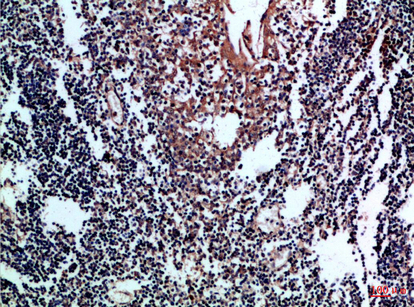CD80 Polyclonal Antibody
- Catalog No.:YT6014
- Applications:IHC;IF;ELISA
- Reactivity:Human;Mouse
- Target:
- CD80
- Fields:
- >>Cell adhesion molecules;>>Toll-like receptor signaling pathway;>>Intestinal immune network for IgA production;>>Type I diabetes mellitus;>>Autoimmune thyroid disease;>>Systemic lupus erythematosus;>>Rheumatoid arthritis;>>Allograft rejection;>>Graft-versus-host disease;>>Viral myocarditis
- Gene Name:
- CD80 CD28LG CD28LG1 LAB7
- Protein Name:
- T-lymphocyte activation antigen CD80 (Activation B7-1 antigen) (BB1) (CTLA-4 counter-receptor B7.1) (B7) (CD antigen CD80)
- Human Gene Id:
- 941
- Human Swiss Prot No:
- P33681
- Mouse Gene Id:
- 12519
- Mouse Swiss Prot No:
- Q00609
- Immunogen:
- Synthetic peptide from human protein at AA range: 100-160
- Specificity:
- The antibody detects endogenous CD80
- Formulation:
- Liquid in PBS containing 50% glycerol, 0.5% BSA and 0.02% sodium azide.
- Source:
- Polyclonal, Rabbit,IgG
- Dilution:
- IHC 1:50-200, ELISA 1:10000-20000. IF 1:50-200
- Purification:
- The antibody was affinity-purified from rabbit antiserum by affinity-chromatography using epitope-specific immunogen.
- Concentration:
- 1 mg/ml
- Storage Stability:
- -15°C to -25°C/1 year(Do not lower than -25°C)
- Other Name:
- T-lymphocyte activation antigen CD80 (Activation B7-1 antigen;BB1;CTLA-4 counter-receptor B7.1;B7;CD antigen CD80)
- Background:
- The protein encoded by this gene is a membrane receptor that is activated by the binding of CD28 or CTLA-4. The activated protein induces T-cell proliferation and cytokine production. This protein can act as a receptor for adenovirus subgroup B and may play a role in lupus neuropathy. [provided by RefSeq, Aug 2011],
- Function:
- function:Involved in the costimulatory signal essential for T-lymphocyte activation. T-cell proliferation and cytokine production is induced by the binding of CD28 or CTLA-4 to this receptor.,similarity:Contains 1 Ig-like C2-type (immunoglobulin-like) domain.,similarity:Contains 1 Ig-like V-type (immunoglobulin-like) domain.,subunit:Interacts with adenovirus subgroup B fiber proteins and acts as a receptor for these viruses.,tissue specificity:Expressed on activated B-cells, macrophages and dendritic cells.,
- Subcellular Location:
- Membrane; Single-pass type I membrane protein.
- Expression:
- Expressed on activated B-cells, macrophages and dendritic cells.
- June 19-2018
- WESTERN IMMUNOBLOTTING PROTOCOL
- June 19-2018
- IMMUNOHISTOCHEMISTRY-PARAFFIN PROTOCOL
- June 19-2018
- IMMUNOFLUORESCENCE PROTOCOL
- September 08-2020
- FLOW-CYTOMEYRT-PROTOCOL
- May 20-2022
- Cell-Based ELISA│解您多样本WB检测之困扰
- July 13-2018
- CELL-BASED-ELISA-PROTOCOL-FOR-ACETYL-PROTEIN
- July 13-2018
- CELL-BASED-ELISA-PROTOCOL-FOR-PHOSPHO-PROTEIN
- July 13-2018
- Antibody-FAQs
- Products Images

- Immunohistochemical analysis of paraffin-embedded Human-tonsil, antibody was diluted at 1:100



